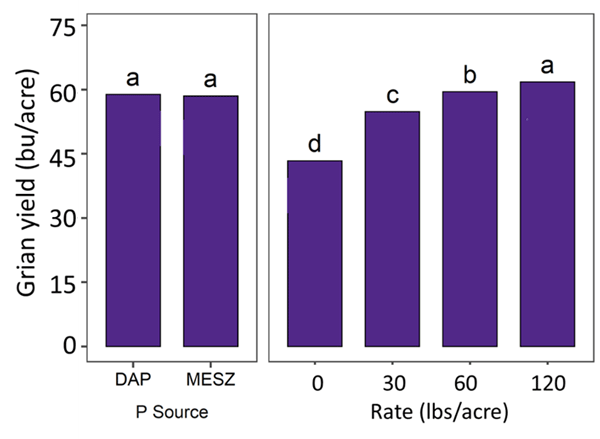Wheat is considered a highly responsive crop to band-applied fertilizers, particularly phosphorus (P). Phosphorus applied as a starter fertilizer can be an effective method for part or all of the P needs. Wheat plants typically show a significant increase in fall tillers (Figure 1) and better root development with the use of starter fertilizer (P and N). Winterkill can also be reduced with the use of starter fertilizers, particularly in low P testing soils.
.gif)
Figure 1. Effects on wheat tillering and early growth with in-furrow P fertilizer on soil testing low in P. Photo taken in 2020 in Manhattan, KS. Photo by Chris Weber, K-State Research and Extension.
In-furrow fertilizer application
Phosphorus fertilizer application can be done through the drill with the seed. In-furrow fertilizer can be applied, depending on the soil test and recommended application rate, either in addition to or instead of any pre-plant P applications. The use of dry fertilizer sources with air seeders is a very popular and practical option. However, other P sources (including liquid) are agronomically equivalent, and decisions should be based on cost and adaptability for each operation.
When applying fertilizer with the seed, rates should be limited to avoid potential toxicity to the seedling. When placing fertilizer in direct contact with wheat seed, producers should use the guidelines in Table 1.
Research conducted at K-State has shown that in-furrow applications of phosphorus fertilizer consistently improved wheat yields compared to no starter, particularly in soils with low soil test phosphorus. Yield responses were similar across P sources (DAP vs. MESZ), but increased as the fertilizer rate increased, with the highest yields observed at 120 lbs/acre (Figure 2). These results highlight that wheat can safely tolerate higher in-furrow P rates, provided application guidelines are followed.
Table 1. Suggested maximum rates of fertilizer to apply directly with the wheat seed
|
|
Pounds N + K2O (No urea-containing fertilizers) |
|
|
Row spacing |
Medium-to-fine |
Course textures or dry soils |
|
15 |
16 |
11 |
|
10 |
24 |
17 |
|
6-8 |
30 |
21 |

Figure 2. Wheat grain yield response as affected by phosphorus fertilizer source and application rate. Graph by Dorivar Ruiz Diaz, K-State Research and Extension.
Air seeders that place the starter fertilizer and seed in a 1- to 2-inch band, rather than a narrow seed slot, provide some margin of safety because the concentration of the fertilizer and seed is lower in these diffuse bands. In this scenario, adding a little extra N fertilizer to the starter is less likely to injure the seed - but it is still a risk.
What about blending dry 18-46-0 (DAP) or 11-52-0 (MAP) directly with the seed in the hopper? Will the N in these products hurt the seed?
The N in these fertilizer products is in the ammonium-N form (NH4+), not the urea-N form, and is much less likely to injure the wheat seed, even though it is in direct seed contact. As for rates, the guidelines provided in the table above should be used. If DAP or MAP is mixed with the seed, the mixture can safely be left in the seed hopper overnight without injuring the seed or gumming up the works. However, it is important to keep the wheat mixed with MAP or DAP at a lower relative humidity. Humidity greater than 70% will result in the fertilizer taking up moisture and will cause gumming or caking within the mixture.
Although the wheat response to these in-furrow fertilizer products is primarily from the P, the small amount of N that is present in DAP, MAP, or 10-34-0 may also be important in some cases. If no pre-plant N was applied, and the soil has little or no carryover N from the previous crop, the N from these fertilizer products could benefit the wheat.
Dorivar Ruiz Diaz, Nutrient Management Specialist
ruizdiaz@ksu.edu
Chris Weber, former Graduate Research Assistant, Soil Fertility
Tags: wheat starter fertilizer phosphorus soil fertility in-furrow